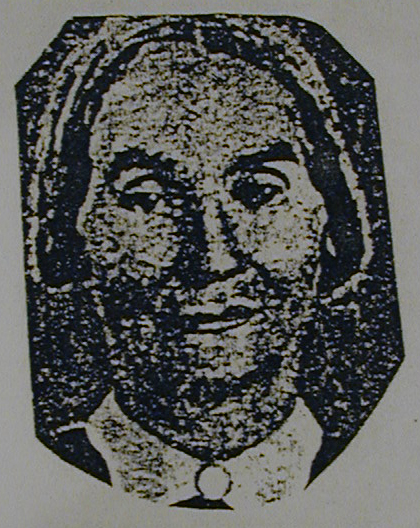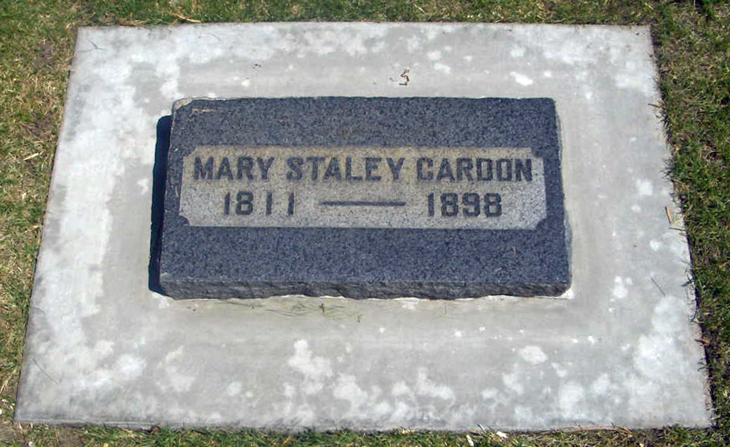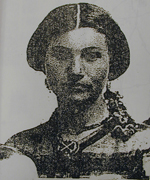By Geneal Norris Lundquist Gilmore – Great Great Grand-daughter
(One incredible story of faith involving the Captain Edmund Ellsworth Handcart Company–the first handcart company to reach Salt Lake City, Utah in the summer of 1856)
MARIE STALLÉ WARREN
The subject of this sketch was born August 15, 1844 at a village in Northern Italy, Angrogna, Torino, Italy. Her parents, Jean-Pierre and Jeanne-Marie (Gaudin-Moise) Stallé were of French descent and belonged to a Protestant group known as Vaudois or Waldenses. This group had suffered much severe persecution and during several generations, in spite of which it still clung to the faith of the fathers. It was a group, therefore, that was characterized by strong religious convictions, for which many thousands of them had fought and died during previous generations. The story of their persecutions is one of the saddest of all the sad, inhuman persecutions that blacken the pages of civilization in Europe during the Reformation. Among these people there went a few missionaries of the Church of Jesus Christ of Latter Day Saints, who first began their labors in 1850, under the direction of Apostle Lorenzo Snow, who became the fifth President of the Church, in 1898. The missionaries met with great success, thirty families from this small group joined the Church. One of these converts was the father of Marie (Stallé) Warren. They were baptized about 1853.
Jean-Pierre Stallé had married Marie Rivoire, 20 August 1829; she died leaving one child, a baby girl, who lived to womanhood, married, did not join the Church and remained in Italy. She died in 1909. Later he married Suzanne Gardiol, 14 May 1834, who also died, leaving a baby boy, who lived to be about two years old. About 2 years later on May 11, 1836, he married Jeanne-Marie Gaudin-Moise, the mother of Marie (StaIIé) Warren. They were small farmers who were able to live only by dint of hard work and the strictest economy. The country where they lived in Italy was very hilly and the hillsides were covered with chestnut trees, fig trees and grape vines. It is some what warmer there than it is here. The frosts are not so hard and the winters are not so cold. Pierre Stallé raised fruit and farmed and he also kept a few cattle. The farms were small and each family made of what they had. They made their own clothing, spinning the yarn and weaving it as they did in the early days.
The Stallé family lived at first in the Angrogna Valley, where 3 children were born; Susanne or Susette (as she later was called), 12 February 1838; Bartholomé, I July 1840, Marie, 15 August 1844. Marguerite, 28 October 1850 was born at Prarostino, Torino, Italy. Pierre invested in sheep and a disease got among them, from which they all died. At the same time the phylloxera attacked the grapevines. After these misfortunes over a period of several years, he was compelled to sell his farm in Angrogna and move to Prarostino where he owned another farm, and where their last child was born. This was farther in the hills and not as good as the one he had to sell. The Stallé family belonged to the Waldenses, who were not numerous. They were found to be some 35 miles south west of Torino in the fertile and well-wooded valley of the Pellico and in the neighboring valleys. The history of their origin is obscure because it was largely written by their enemies. Catholics regard them simply as the followers of Pierre Valdo (or Valdes) of Lyons, France. They themselves repudiate this view and push back their beginnings to the age of primitive Christianity, claiming to have preserved the purity of the faith through the ages and that the Church was founded by St. Paul on his way from Rome to Spain. Another theory of their origin is that the sect had it’s origin in the time of Constantino as a reaction against the corruption of the Church of the Fourth Century.
What seems more probable, however, is that the sect resulted from a fusion of the heretical followers of Claude of Torin (8th century), Arnold of the Brescia (executed in Rome 1155), Peter of Bruys (1104-125), and Pierre Valdo who died in Bohemia in 1217. Valdo, a rich merchant of Lyons, had disposed of his property, giving part of it to his wife and the rest to the poor, and had begun preaching, at first as a lay member of the Catholic Church, and then continued to preach after he had been ex-communicated. Many of his followers took refuge in the Cottian Alps or in what was also to be known Vaudois Valleys. Pierre Valdo secured a translation of the Bible into the language of Southern France, the Provencal. This has served as a basis for later French translations. The sect was subjected to terrible persecutions. The writer in Hasting’s “Encyclopedia of Religion and Ethics”, vol. 12, page 664, says “They were able to withstand ‘the attacks of opponents in a way that has almost suggested the miraculous. We need to realize the physical characteristics of the area in which it (the people) grew up in order to understand it’s rare characteristics and account for it’s sturdy independence and heroic achievements”.
Mention may be made of some of these persecutions. In 1487, Innocent VIII issued a bill for the extermination of the Waldenses, and Alberto de Capitanei, Arch Deacon of Cremona, put himself at the head of a crusade against them. In 1655, French troops of Louis XIV and Irish soldiers who had fled before Cromwell were garrisoned in the Valleys.
In 1685, the Edict of Nantes which had granted freedom of worship in France was revoked and a persecution which aimed at entire extermination was begun. The resistance of the Waldenses in the guerrilla warfare was so, stubborn that 2600 of them were permitted to withdraw to Geneva. From Geneva they scattered over Switzerland and a number passed into Germany. Four years later, however, their ‘pastor Henri Arngud, led a band of 800 to a re-conquest of the Valleys. The writer in Hasting’s “Encyclopedia” says that they made “one of the most magnificent stands of religious liberty ever recorded in the annals of history”. In 1685 all Church records that, could be procured, together with their Churches, were burned by the troops of Louis XIV. One document bearing the date 1280 survived this burning. It contains the name Stallé as an-inhabitant of the Valley of the Angrogna which was later to be the birthplace of Jean-Pierre Stallé, father of Marie.
In 1855 the Stallé family received word from Franklin D. Richards, President of the European Mission, that they could go to Zion, and they were ready in two weeks. It was impossible to sell the place in so short a time and it was left without their receiving anything for it. The missionaries were persecuted a great deal, and soon (1862) were driven out altogether, and there have been no missionaries there since.
When the missionaries came to the Stallé house, the family gave them the best they had, gave them their best bed, and slept on a poor one. Their home was always open. The last time Elder F. D. Richards was there before he left for Zion, he came in the early morning hours to escape from the officers, got a bite to eat and a moment to rest. At that time he told them they would soon be leaving for Zion. The family, three weeks later left Prarostino and traveled probably like the Malin family two years before, in carriages to Pignerol and from there to Torino, the Capitol of Piedmont, thence to the town of Susa by railway; then up the steep Mt. Cenis in a large coach placed on sleds and drawn by sixteen Government mules, much of the way covered by perpetual snow and ice. Then on to Loundsburg on the Savoy side where the coaches were taken from the sleds, and then by coach to Lyons, France. From Lyons they traveled by railway to Liverpool, where they remained a short time while waiting for the ship to sail. The family left Liverpool on the 12 of December 1855. They are listed on the list of emigrants sailing on the ship “John J. Boyd” as follows:
Pierre StaIIé, 48, agriculturist
Marie Stallé, 45
Susanne Stallé, 19
Bartholomé StaIIé, i6
Marie Stallé, 11
Margaret Stallé, 5
The following is taken from a letter describing the voyage written by C. R. Savage and published in the “Millennial Star”, vol. 15, p. 209: “We left Liverpool on Wednesday, December 12, at seven a.m., and had a fine run down the channel, sighting Cape Clear on the Friday morning following, and had mild weather with a fair wind for three days after. During this time we had leisure plans for the maintenance of order and cleanliness during the voyage. P.S. —— I don’t have the history of the voyage —- On arriving they went by rail to Dunkirk and Cleveland and to Chicago, where the company, according to previous arrangements, was divided into three parts, of which one, consisting of about one hundred and fifty souls, went to Burlington, Iowa. Another to Alton, Illinois and a third to St. Louis, Missouri (the one Marie Stallé was on). Most of those who went to Burlington and Alton remained in those places or near them a year or two working to earn means wherewith to continue the journey. The part or company which went to St. Louis arrived in that city on the 10th of March and soon afterwards, continued the journey to Florence, Nebraska, where they joined the general emigration that crossed the plains in 1856.”
Pierre Stallé’s wife Jeanne-Marie, desired to earn means and come by ox team; Pierre, himself wanted to follow the advice of Brother Richards and come on at once. In consequence, they joined the first Edmund Ellsworth handcart company at Florence, Capt. A. GaIloway, Sec. (Please note: From the Diary of Edmund Ellsworth as written in “Our Ellsworth Ancestors” by German E. & Mary Smith Ellsworth, 1956, page 105: August 17th. The camp moved out at a quarter to nine a.m. and traveled twelve miles. We crossed over Wolf Creek and ascended the Sandy Bluff. We crossed the bluff to the left instead of going up the old tract. It is easier for handcarts and for ox teams. The road today was very sandy for several miles. Passed over several creeks. Camped at four p.m. on the side of the Platte opposite to Ash Grove (or Ash Hollow). (click here to see Map of Nebraska). Brother PETER STALLEY died today. He was from Italy. (48 years old).
The handcart company had left Iowa City, the Mormon outfitting post, June 9, 1856, the FIRST HANDCART COMPANY to cross the plains to Salt Lake City. The distance was about 1300 miles. There were no real roads, only trails, and these were usually rough. The plains were dry and hot. In many places water and fuel were scarce. Even food was never any too plentiful, often short. The carts had to be lightly loaded, for they were to be pulled and pushed by the foot sore pedestrians; all who were able, toiled at the carts. Is it any wonder that many were overtaxed and died on the way, due to exposure, lack of enough suitable food and other hardships. Of course, the emigrants could carry in their carts no furniture or heavy belongings, only a scanty supply of clothes, food and bedding.
If they had more than these, they were asked to leave them behind. Such clothing as the Stallé family had not left behind at Florence, had to be worn constantly in all kinds of weather and to sleep in at night, and was of little value on reaching Salt Lake City. At times they found water scarce and had to dip it out of buffalo tracks after a rainstorm. At other times, unusually long marches were made to reach water and wood. When there was no expectation of finding wood, a sack was hung on the back of the handcart to carry dry buffalo chips picked up on the way. No, they were not afraid of hardships, not even death itself; Liberty and Freedom to worship God in peace were worth any sacrifice, even life itself. A happy, everlasting life beyond the grave and a glorious resurrection were the important things, Soon after beginning the trek, Marie Stallé’s father became ill and later died. HE DIED ON THE NORTH SIDE OF THE NORTH PLATTE RIVER AT ASH HOLLOW, NEBRASKA, (SEE THE MAP). Her mother was still weak from the long sickness suffered on the trip across the Atlantic, leaving Liverpool on 12 December 1855 sailing on the ship “JOHN J. BOYD”. So the family handcart had to be pushed by her sister, Susanne, age 19 years old. Her 16 year old brother; Bartholomé (Daniel) also pushed. Marie was old enough to walk all day but her little sister Margaret had to sit in the cart. She was only 3 years old.
The body of her father was wrapped in a sheet, placed in a wayside grave between two layers of sagebrush and covered with earth. On the day of his death he told his family that he could not go on, but that they would reach the Salt Lake Valley in safety and would never want for bread. This was a remarkable prophecy. A penniless widow and four children that could not speak English were on their way to a poverty- stricken country; yet, the dying father told them that they would never suffer for the need of bread, and they never did.
The companies arrived in Salt Lake September 26, 1856, having been more than three months on their weary trek. The problem for the widow and her children was very difficult, aggravated by the language handicap. However, the courageous woman was undaunted. The older girls found homes in which to work, and the mother, son and Margaret went to Ogden to live near other friends. There the mother and her son made a dug-out, one room in the side of a hill (27th Street) to live in. The roof of the dug-out was made of willows, covered with bulrushes then dirt. The dirt floor was covered every Saturday with fresh straw whenever they could get it. They had no furniture, but for a bed and seat, forked sticks were put in the wall and in the dirt floor and rushes were woven in between and covered with straw. In place of glass for a window a piece of cloth was used. For bread the family gleaned in the fields and gathered enough wheat for their winter’s supply. The mother knew how to spin and weave in the old country. Margaret gathered sunflowers for candles and burned them one at a time holding them in her hands so her mother could see to spin at night. She worked out during the day as much as she could.
The family lived in the one room dug-out for about eighteen, months, and then in the early summer of 1858, joined in the general move of the Saints to the South, due to the coming of Johnston’s Army. Returning to Ogden later in the year after the troubles, due to President Buchanan’s blunder having been adjusted, the family continued to live there a year or two, maintaining itself the best it could. Then the mother moved to Logan, taking her son and Margaret with her.
Marie then married a young man, Elihue Warren, who was born in Thompson, Ohio. They homesteaded in what is now called North Ogden. They had eight boys and five girls. They are: Francis, Nathan, Walt, Albert, Henry, Lorenzo, Ret, Landy, Marlvin, Austin, Rose, Susan and Iley. Marie (Stallé) Warren (Mary Staley) , died January 28, 1929 at North Ogden and was buried in the North Ogden Cemetery. She died at the home of her son, Henry; Susan was with her at the time.

Marie’s mother married March 21, 1863, her second husband Phillipe Cardon. Her sister Susanne. (or Susette) married July 10, 1871, Louis Phillip Cardon, and she died July 19, 1923. Her brother Bartholmé (Daniel) married Anne Christena Christensen and he died January 15, 1912. Her youngest sister, Marguerite (known as Margaret), married November 30, 1867, Henry Barker and she died April 9, 1938. Margaret’s birth record says she was born the 28th of October 1850, but she always celebrated her birthday on the 20th.
This history was sent to me many years ago by my Aunt Delta Murri.
Typed April 1981 by Raeola (Ford) Cooke.
Grave Marker of Marie’s mother – Jeanne-Marie Gaudin-Moise Stalé
Hyrum City Cemetery, Hyrum, Cache, Utah


